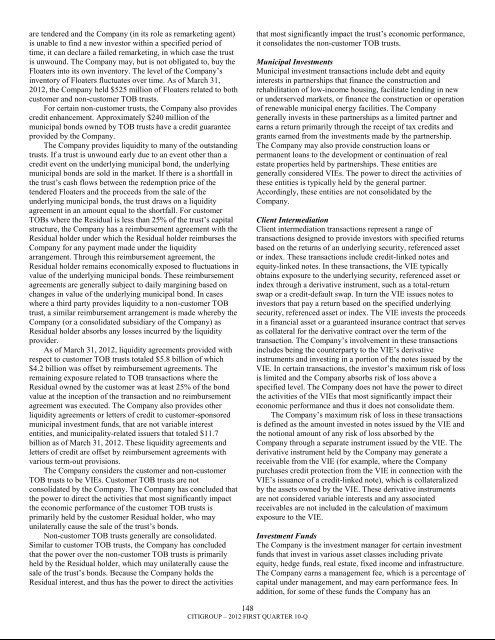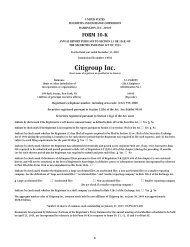7.3 billion - Citigroup
7.3 billion - Citigroup
7.3 billion - Citigroup
Create successful ePaper yourself
Turn your PDF publications into a flip-book with our unique Google optimized e-Paper software.
are tendered and the Company (in its role as remarketing agent)is unable to find a new investor within a specified period oftime, it can declare a failed remarketing, in which case the trustis unwound. The Company may, but is not obligated to, buy theFloaters into its own inventory. The level of the Company‘sinventory of Floaters fluctuates over time. As of March 31,2012, the Company held $525 million of Floaters related to bothcustomer and non-customer TOB trusts.For certain non-customer trusts, the Company also providescredit enhancement. Approximately $240 million of themunicipal bonds owned by TOB trusts have a credit guaranteeprovided by the Company.The Company provides liquidity to many of the outstandingtrusts. If a trust is unwound early due to an event other than acredit event on the underlying municipal bond, the underlyingmunicipal bonds are sold in the market. If there is a shortfall inthe trust‘s cash flows between the redemption price of thetendered Floaters and the proceeds from the sale of theunderlying municipal bonds, the trust draws on a liquidityagreement in an amount equal to the shortfall. For customerTOBs where the Residual is less than 25% of the trust‘s capitalstructure, the Company has a reimbursement agreement with theResidual holder under which the Residual holder reimburses theCompany for any payment made under the liquidityarrangement. Through this reimbursement agreement, theResidual holder remains economically exposed to fluctuations invalue of the underlying municipal bonds. These reimbursementagreements are generally subject to daily margining based onchanges in value of the underlying municipal bond. In caseswhere a third party provides liquidity to a non-customer TOBtrust, a similar reimbursement arrangement is made whereby theCompany (or a consolidated subsidiary of the Company) asResidual holder absorbs any losses incurred by the liquidityprovider.As of March 31, 2012, liquidity agreements provided withrespect to customer TOB trusts totaled $5.8 <strong>billion</strong> of which$4.2 <strong>billion</strong> was offset by reimbursement agreements. Theremaining exposure related to TOB transactions where theResidual owned by the customer was at least 25% of the bondvalue at the inception of the transaction and no reimbursementagreement was executed. The Company also provides otherliquidity agreements or letters of credit to customer-sponsoredmunicipal investment funds, that are not variable interestentities, and municipality-related issuers that totaled $11.7<strong>billion</strong> as of March 31, 2012. These liquidity agreements andletters of credit are offset by reimbursement agreements withvarious term-out provisions.The Company considers the customer and non-customerTOB trusts to be VIEs. Customer TOB trusts are notconsolidated by the Company. The Company has concluded thatthe power to direct the activities that most significantly impactthe economic performance of the customer TOB trusts isprimarily held by the customer Residual holder, who mayunilaterally cause the sale of the trust‘s bonds.Non-customer TOB trusts generally are consolidated.Similar to customer TOB trusts, the Company has concludedthat the power over the non-customer TOB trusts is primarilyheld by the Residual holder, which may unilaterally cause thesale of the trust‘s bonds. Because the Company holds theResidual interest, and thus has the power to direct the activitiesthat most significantly impact the trust‘s economic performance,it consolidates the non-customer TOB trusts.Municipal InvestmentsMunicipal investment transactions include debt and equityinterests in partnerships that finance the construction andrehabilitation of low-income housing, facilitate lending in newor underserved markets, or finance the construction or operationof renewable municipal energy facilities. The Companygenerally invests in these partnerships as a limited partner andearns a return primarily through the receipt of tax credits andgrants earned from the investments made by the partnership.The Company may also provide construction loans orpermanent loans to the development or continuation of realestate properties held by partnerships. These entities aregenerally considered VIEs. The power to direct the activities ofthese entities is typically held by the general partner.Accordingly, these entities are not consolidated by theCompany.Client IntermediationClient intermediation transactions represent a range oftransactions designed to provide investors with specified returnsbased on the returns of an underlying security, referenced assetor index. These transactions include credit-linked notes andequity-linked notes. In these transactions, the VIE typicallyobtains exposure to the underlying security, referenced asset orindex through a derivative instrument, such as a total-returnswap or a credit-default swap. In turn the VIE issues notes toinvestors that pay a return based on the specified underlyingsecurity, referenced asset or index. The VIE invests the proceedsin a financial asset or a guaranteed insurance contract that servesas collateral for the derivative contract over the term of thetransaction. The Company‘s involvement in these transactionsincludes being the counterparty to the VIE‘s derivativeinstruments and investing in a portion of the notes issued by theVIE. In certain transactions, the investor‘s maximum risk of lossis limited and the Company absorbs risk of loss above aspecified level. The Company does not have the power to directthe activities of the VIEs that most significantly impact theireconomic performance and thus it does not consolidate them.The Company‘s maximum risk of loss in these transactionsis defined as the amount invested in notes issued by the VIE andthe notional amount of any risk of loss absorbed by theCompany through a separate instrument issued by the VIE. Thederivative instrument held by the Company may generate areceivable from the VIE (for example, where the Companypurchases credit protection from the VIE in connection with theVIE‘s issuance of a credit-linked note), which is collateralizedby the assets owned by the VIE. These derivative instrumentsare not considered variable interests and any associatedreceivables are not included in the calculation of maximumexposure to the VIE.Investment FundsThe Company is the investment manager for certain investmentfunds that invest in various asset classes including privateequity, hedge funds, real estate, fixed income and infrastructure.The Company earns a management fee, which is a percentage ofcapital under management, and may earn performance fees. Inaddition, for some of these funds the Company has an148CITIGROUP – 2012 FIRST QUARTER 10-Q
















